Cthulhu’s Open Call
Cosmic dread has captured the art world. An exhibition of meme paintings awakens an eldritch horror. This critic turns occult investigator.
The sciences, each straining in its own direction, have hitherto harmed us little; but some day the piecing together of dissociated knowledge will open up such terrifying vistas of reality … that we shall either go mad from the revelation or flee from the deadly light into the peace and safety of a new dark age.
— H P. Lovecraft, The Call of Cthulhu
I heard the nameless groan myself that fateful September night at The Hole. “Cthulhu fhtagn.” It was the opening for CryptoFIRE Degen, an exhibition of crypto-themed meme paintings by one Christine Tien Wang, a San Francisco-based artist. We stood transfixed by cyclopean Angelina Jolie, Drake, Janet Yellen. The labyrinthian space was lit like an asylum and rapidly filled with toxic paint fumes from the freshly minted work. My companions and I stayed for the free lychee margaritas. We buzzed around like flies marveling at each terrible painting. Thirteen in total: an ominous number. We watched the gallery attendant refill the margarita tank with just tequila, no mixer. The wicked potion drove us into a state of delirium that kept us trapped in that infernal place for hours.
Deep in that altered state – drunk, poisoned, demented – a horrible realization struck me, and I heard It. Just as Lovecraft forewarned, “That glimpse, like all dread glimpses of truth, flashed out from an accidental piecing together of separated things.” I became giddy to the point of mania, a babbling lunatic, unrecognizable from my former sullen self. By morning, only the call of Cthulhu remained. It possessed me and became my sole obsession for months on end. It’s taken everything I have to reconnect the fragments of truth I glimpsed that night.
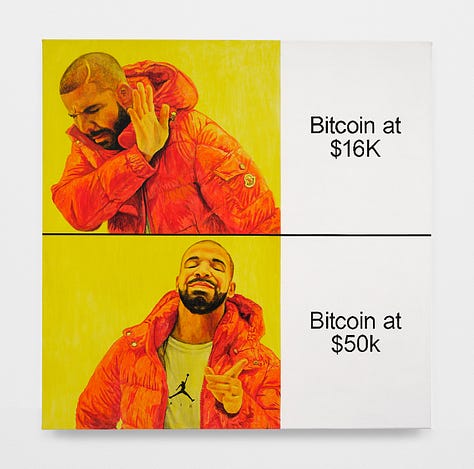

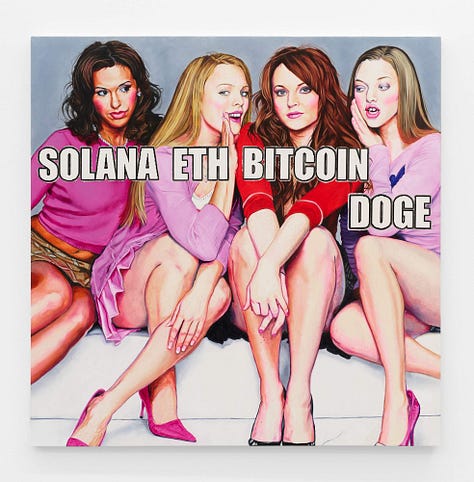
My investigation began with the decipherment of CryptoFIRE Degen’s forbidden language. Wang’s paintings are mirrors of digital memes down to the crusty image compression artifacts. From a distance, they look like the “real memes” you’d see on a screen. At the opening, I asked the other attendees what they thought. One man wearing bedazzled baby blue Gucci loafers said: “They’re statement.” Another pair of men laughed nervously and pointed out that “It was just like standing inside Facebook.” An alarming and enticing concept – but something was wrong.
Nobody thought they were funny. Or provocative, or even current. What mattered was their size and profanity, but after standing around long enough, they become less shocking and more uncanny, dissolving like a mirage. Our eyes tell us that Wang’s paintings are of memes, but they’re not memes. What they actually represent is a ranked list of pop culture references from the last fifteen years fed into a randomizer and organized into the formal appearance of a meme. But they have no provenance, no unwashed internet “poor image” aura, and thus are unreadable, unhuman. They’re “broken images”, unable to capture the feeling of a true meme, which is a wretched, despairing object, desperate to be liked, destined to be hated. That’s a lot of material for an artist to work with, but not for Wang. Her paintings are hollow facsimiles, not of memes, but of art about memes. It’s like her paintings were designed to fool us by some Thing that doesn’t live in the same world we do.
The art confused the gallerists and interviewers, too, who don’t know what to do with CryptoFIRE Degen. The gallery’s press release offers a panicked plenitude of justifications: the paintings are “scalding-hot takes” which critique crypto, the attention economy, the art market, even the objectification of women. But Wang ignores the script and reveals her curious motivation in a cagey Interview Magazine profile. “My goal is to embarrass myself,” she says. Is cringe the content? I don’t think she’s operating on that level. It seems to me that she is hiding something. In the course of the interview, she says scant little, deflects most questioning, and calls painting a “dead medium.” Whether she’s hiding real shame or apathy, I can’t be sure. Whatever her game is, it’s not about the production of art. It’s the fulfillment of a role: perhaps one that she never wanted in the first place. It makes me wonder who the victim is here. Is it We the Audience, Art the Eternal, or Wang the Artist? She corrects her faux pas: “Well, not dead, but it’s certainly a very crude technology compared to a computer.” Yes, very good. We’re getting closer.
Wang Awakens the Old One
Boramir Moon and Boramir Retire Early (2024), both titles notably misspelled, reveal the suffering nightmare that animates CryptoFIRE Degen. Wang is like an algorithm fine-tuned to manufacture art, no doubt for a very particular clientele. She ran her simulations and forfeited her perspective as an artist to the numerically dominant image-form. There is no pop gesture, no appropriation, no anti-art, no détournement. Wang merged with the market and in doing so made an accursed portrait of torturous alien infinity. Each meme screams and implodes in hypercommodification, sucking all the paintings, the gallery, the Bowery, the artist, and myself into a black vortex of Nothingness. I hear the dread call again: the call of Cthulhu! The Hole becomes A Hole and the sun winks away while the gallery admins make a last ditch attempt at damage control. “I think the artist feels more about the content than she lets on,” they exclaim, “and feels more about painting itself.” WRONG! Too little, too late.
The Thing cannot be described—there is no language for such abysms of shrieking and immemorial lunacy, such eldritch contradictions of all matter, force, and cosmic order. What an age-old cult had failed to do by design, a band of innocent sailors had done by accident. After vigintillions of years great Cthulhu was loose again, and ravening for delight.
Wang answered Cthulhu's call. She erected thirteen graven idols and awoke the slumbering eldritch horror. Her calamitous show was the final knell for a bell that’s been tolling for years. All the pieces lie before us: the fearful Whitney and Venice Biennials, Andrew Norman Wilson’s flamboyant retirement, a rotten downtown “avant-garde”, Brat Summer, Norman Finkelstein at Sovereign House, Generative AI, the TikTok art critics, another banana sold for $6.2 million — madness all! It’s all connected, Nothingness abounds, Meaning is lost, Darkness reigns. CTHULHU!
The veil of order masking our decaying world has lifted, and we all know it. I can assure you this no coincidence: it has been wrought by the Old One. Once-secret truths can’t be escaped any longer. Art is just one of many sinking ships, and it’s sinking fast. Those who remain on deck will be swallowed up in Cthulhu's hulking maw. Yet the fires still burn in the press release factories, which churn out garble against all sense and reason. Art races to its own destruction, dissolution, and drowning. “Après moi, le déluge,” said decadent Louis XV. “Après moi, le déluge,” said Marx’s capitalist. “Après moi, le déluge,” says the gallerist.
Into The Hole
Beaubourg-Effect ... Beaubourg-Machine ... Beaubourg-Thing – how can we name it?
— Jean Baudrillard, Simulacra and Simulation (1981)
What can we do to save art? We must look to the heroes of our past. There came an occult investigator before me, forty-some years ago. Spurred by the frenzied market of the 1980s, Cthulhu rose up as Jean Baudrillard’s great nemesis, the Centre Pompidou (aka “Beaubourg”). At the time, Baudrillard already knew that art had died. It had been absorbed into all aspects of life, media, and advertising. The western world was dominated by “seductive objects” that simultaneously captivated and bored the masses as it lost all aura and reference to a primordial “real.” Art, alongside mass media and consumerism, had become inert. To arrange dead art in a new museum amounted to holding a funeral for culture.
“What, then, should have been put inside Beaubourg? Nothing,” Baudrillard claimed, save for “perhaps a spinning of strobe lights and gyroscopes.” He invented a facetious revolutionary slogan, “MAKE BEAUBOURG BUCKLE!”, and proposed stampeding the museum with 30,000 visitors to overload its weight limit and physically destroy it. This exemplifies Baudrillard’s “fatal strategies”: exacerbating the self-destructive tendencies of an over-consumptive system in order to accelerate its ultimate demise. Although Baudrillard famously broke from Marxism, the fatal strategy is a descendent of Marx’s historical dialectic, which found the seed of change within the excesses of overproduction and alienation. In Fatal Strategies (1983), Baudrillard outlined his methodology:
We will find subtle forms of radicalizing secret qualities;
We will fight obscenity with its own weapons.
We will not oppose the beautiful to the ugly, but will look for the uglier than ugly: the monstrous.
We will not distinguish the true from the false, but will look for the falser than false: illusion and appearance.
The strategy is fatal because it suggests that resistance is futile; the only way forward is to surrender to simulation and collapse — implosion. The economic and cultural system we have built has long proven its aptitude at absorbing all attempts at protest and revolution, especially in the arts (provoking some critics to disown contemporary attempts at critical, political, or “woke” art and criticism). After the end of history, art seems doomed to die over and over in a sick karmic cycle. The hair-pulling critics of our time fear and loathe this system, but can’t figure out how to escape. They’re (we’re) implicated in the system, too. They want to keep the dream alive, and now desire a new set of seductive objects that haven’t been exhausted yet. What they’re asking for can only serve to mesmerize them for a few sublime moments before being subsumed and nullified — but not before slamming out an article. Cry as they might, the undead art hanging in the galleries can’t hear them, and Cthulhu laughs in the deep. We must all accept that there is no resuscitating “fine art”. There is no “crisis” to avert or revert. The show must go on because consumption must go on, forever, amen. Unless…?
The work of art — a new and triumphant fetish and not a sad alienated one — should work to deconstruct its own traditional aura, its authority and power of illusion, in order to shine resplendent in the pure obscenity of the commodity. It must annihilate itself as familiar object and become monstrously foreign.
— Jean Baudrillard, The Conspiracy of Art (2005)
If we accept that it’s impossible to break free, then the only option is to work from within this position of surrender. Contemporary art can, or could, and sometimes does, locate itself here — by adopting what Baudrillard calls a “higher irony” to turn the dials up on the production of obscene, illusory art, and ultimately bankrupt the value system holding it all together. Aha! Baudrillard’s occult discovery was that Cthulhu isn’t our foe, but rather, our comrade. He has risen again to shake us from our illusions and nostalgic fantasy and return us to the real. He is the ultimate obscenity, the monstrosity that implodes all art. I realize now that Baudrillard didn’t pacify or defeat Cthulhu — he absorbed him. Cthulu is the fatal strategy.
Le déluge
Nullity, however, is a secret quality that cannot be claimed by just anyone. Insignificance - real insignificance, the victorious challenge to meaning, the shedding of sense, the art of the disappearance of meaning - is the rare quality of a few exceptional works that never strive for it.
Wang is vindicated. The fatal stupidity of CryptoFIRE Degen toppled the tyranny of art – if only for a night. Like Baudrillard’s spinning strobe lights, Wang’s hollow hyperrealities are actually poison pills. We need more Drake, more Boramir Moon, more ignorance, more meltdown. Fill the galleries with AI slop, factory-made crap, cheap 3D prints, shitty ideas, and ungodly exhibition text. So what if the downtown artists have been seduced by their own image as the “cool downtown artist”? This is the art: being a cool downtown artist. The art itself is irrelevant—always has been. Have at it! So we must be cool too, cooler than cool, the most avant-garde, the most meta. We are deep in the hyperreal nebula. Embrace it. And stop complaining!
Cthulhu slumbers and Wang’s memes take his place. They become my New Gods, I their cult worshipper. In our cult, the meme paintings offer freedom from the oppression of contemporary art and its discourse. They shake us from our catatonia and depression. They freed me, O Gods, from interpretation, and allowed me to bask in the blistering heat and silence, the lychee margaritas, the airborne ammonia and turpentine. As dear Jean put it: “Too bad. We’re in paradise.”
Liberation, transcendence, the implosion of art and kitsch, human and AI. Henceforth I am no longer able or required to justify myself or my opinions. The chatbots will do it for me. Literacy fades from my mind, and I forget how to read, write, and, finally, to speak. There is simply nothing, and it is beautiful. I’m the monkey before the monolith. History ended, and now we’ve forgotten it, too. It’s the beginning of time: the eternal clock has reset to zero. In the cult of CryptoFIRE Degen, we’ve already exited into the future. Join us.
In any case, there is something stupid about our current situation. There’s something stupid in the raw event, to which destiny, if it exists, could not be insensible. There’s something stupid in the current forms of truth and objectivity that a superior irony could spare us. Everything is expiated in one way or another. Everything is headed somewhere. Truth only complicates things.
— Jean Baudrillard, Fatal Strategies
Who knows the end? What has risen may sink, and what has sunk may rise. Loathsomeness waits and dreams in the deep, and decay spreads over the tottering cities of men. A time will come—but I must not and cannot think!
— H.P. Lovecraft, The Call of Cthulhu

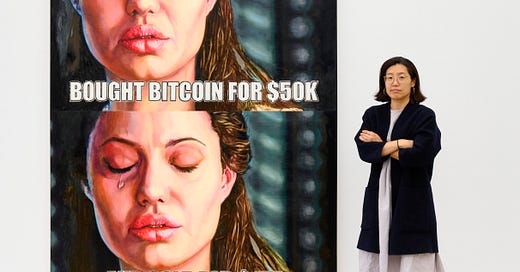


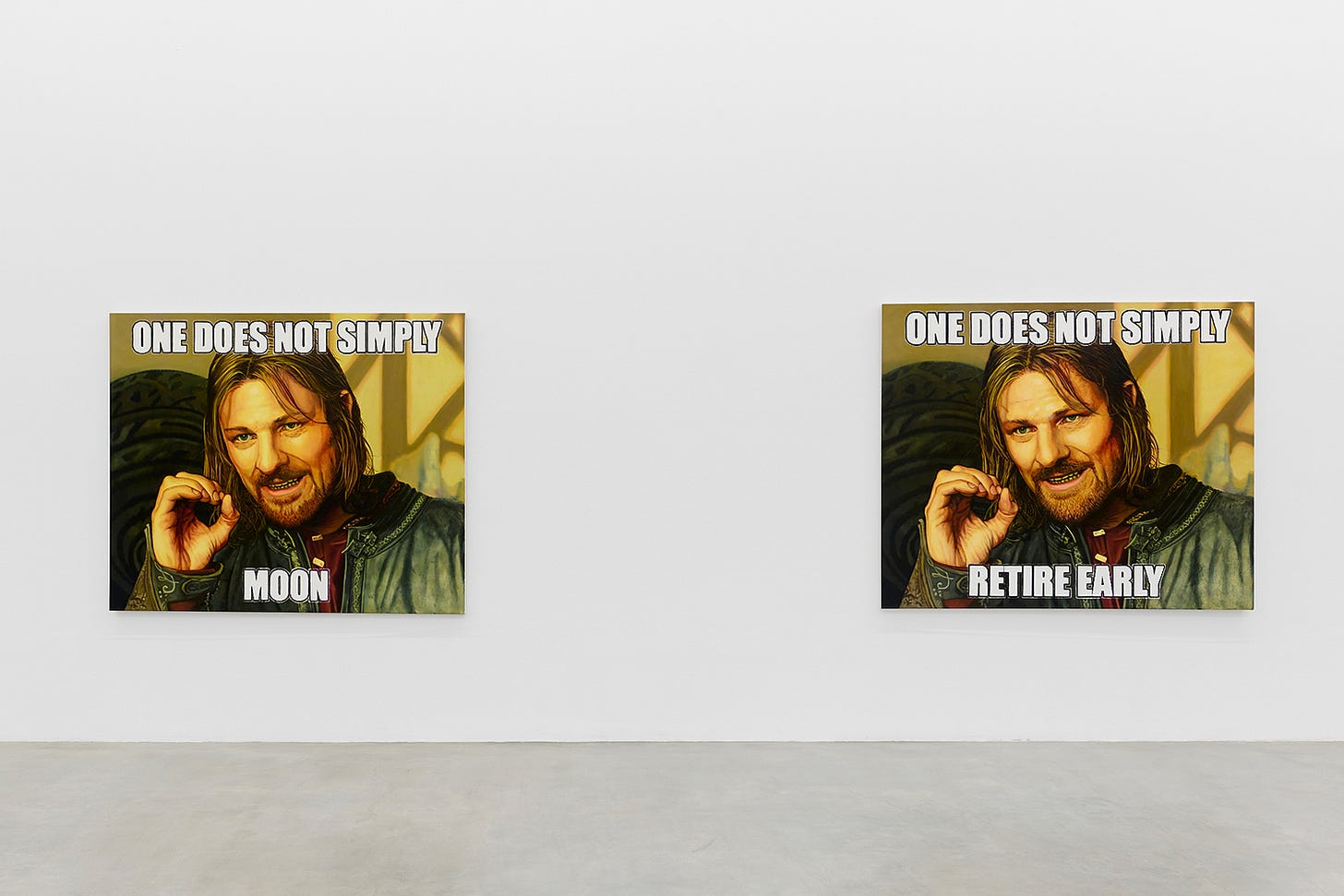
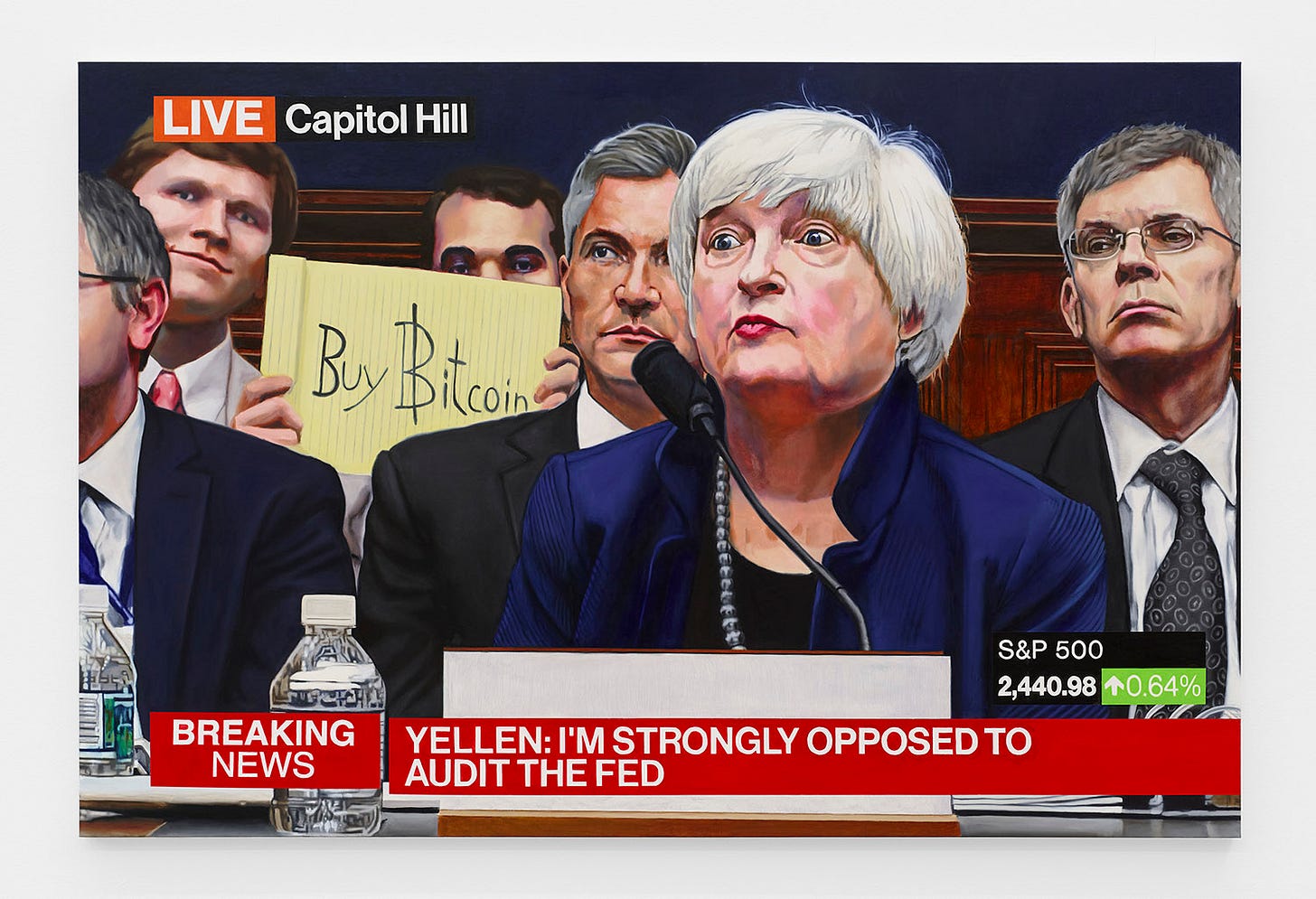
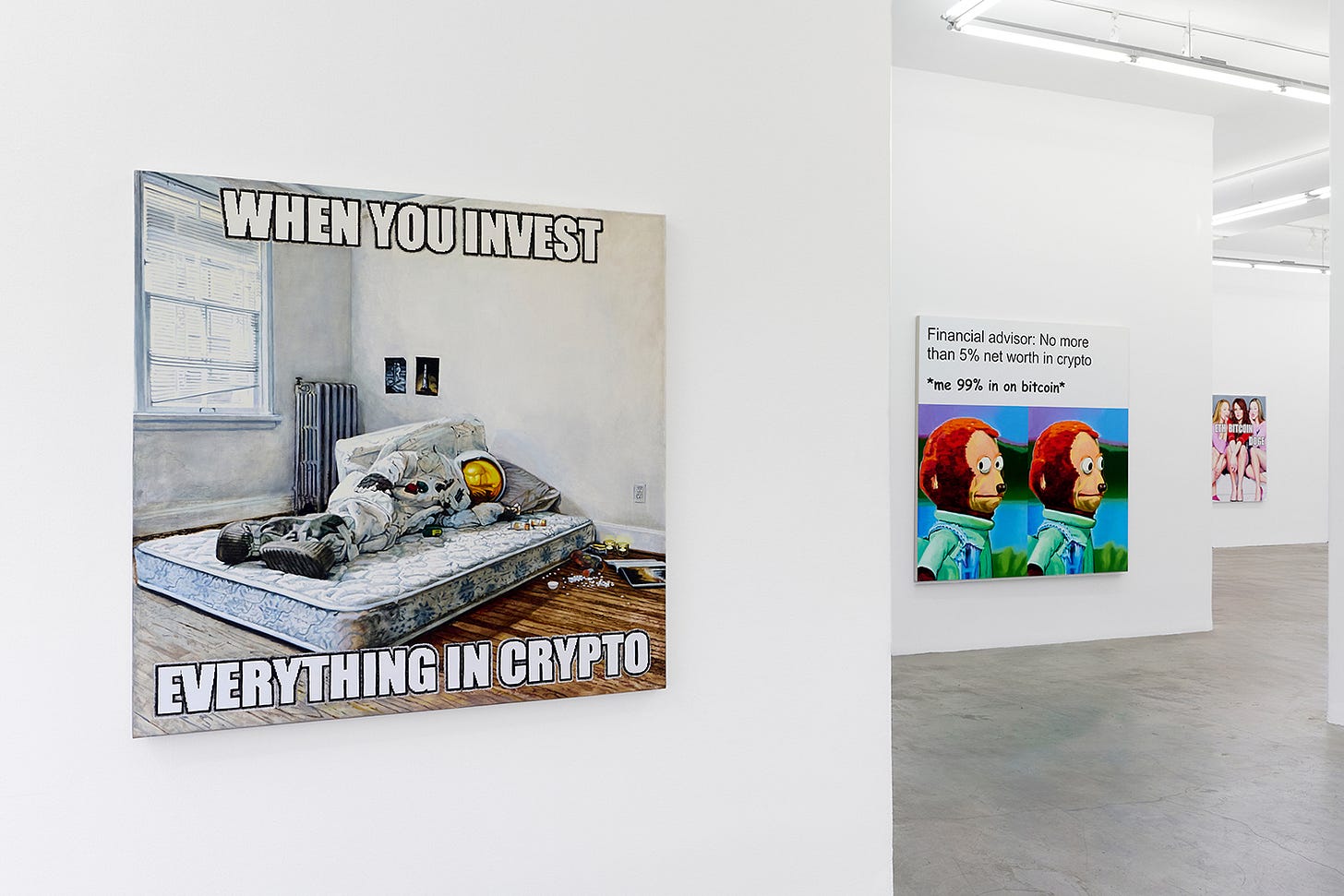
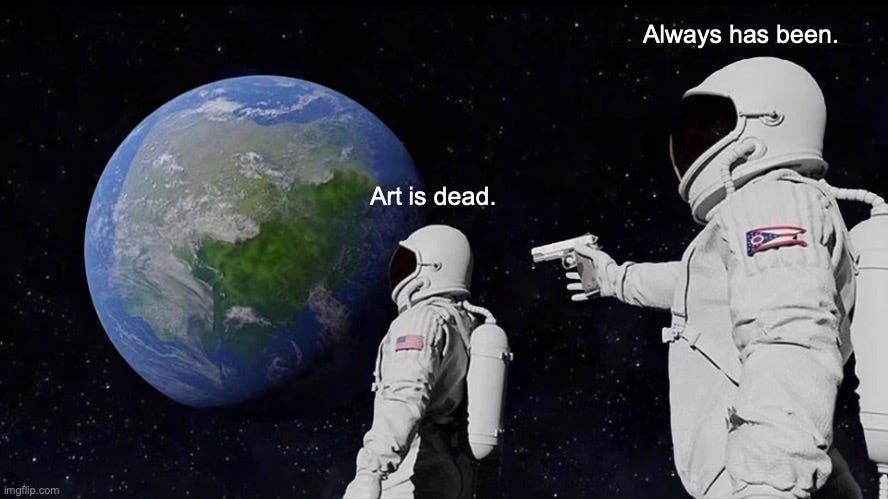
i’m very excited to see this as a talk
Enchantingly amazing